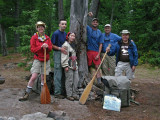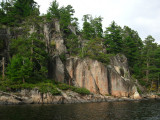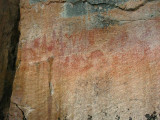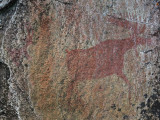
Canoeing in Quetico Provincial Park is the ultimate outdoor vacation. While there were no kids on this trip, it’s important for me to write about and share this experience. Who knows, perhaps I’ll take a group there someday. Well, maybe not… read on and you’ll understand why.
Quetico canoe trips are beautiful and rigorous. We saw so much wildlife that by the end of the trip, Bald Eagles became ordinary. My body grew strong while simultaneously getting beat up. Bruises of all shapes and sizes dotted my arms and legs from slipping on rocks, getting in and out of the canoe or falling with a 70 pound pack on my back. Canoeing the Quetico is a humbling experience and yet remains worth the effort.
Here’s the trip by the numbers:
Dates: August 28 to Sept 4
Duration: 8 days, 7 nights
Total Miles: 80
Portage Miles: 5
Longest Day: 20 miles
Shortest Day: 9 miles
Portages: 28
Longest portage: 1 mile
Shortest portage: 20 feet
Shortest unmarked portage: One step. (Okay technically this wasn’t a portage at all. Rather we had to step carefully on floating pieces of a sphagnum moss to maneuver the canoe through the wetland.)
Truth?
There were times on the trip, such as being stuck knee-deep in the mud with a 45 pound canoe on my shoulders, when I wondered why I would call this a vacation. And yet, it was. The wilderness is rejuvenating. It’s beautiful and everywhere you turn there’s another plant to look at and inspect. The lichen and moss are so diverse, I could write a book just about them. And there’s nothing better than drinking directly from clean, clear lakes. It’s feels like drinking hope.
The images and memories from this trip will last a long time.
Among my favorite images were the pictographs.

Ojibwe people painted pictures on rock walls throughout the Quetico about 400 years ago. We saw the best pictographs in the park on a massive rock wall on Lac la Croix. Approaching the rock wall, I imagined Ojibwe people camping on the nearby beach and visiting the rock wall for ceremonies or to make an offering. I imagined the painters resting on the beach before doing their work.
The images themselves are mysterious. The handprints reminded me of child play. The moose was a work of graceful art.
What do the paintings mean? Why did they do it? It’s easy to think that they were just playing or offering up artistic expression, but that’s not likely because the images are found on rock art elsewhere in the country. This lends credence to the theory that rock art had a spiritual purpose.
The paintings remain bright after hundreds of years due to a paint mixture of iron ore and bear fat. I tend to think that the painters

must have known what they were doing when they made this very durable paint, but how they knew this is a mystery.
Modern Lac la Croix natives continue to worship at these rocks today. We did the same. To honor the drawings and the people who painted them we left a small offering of berries. I also made offerings when we crossed large lakes. Native people did this to protect themselves from the perils of big water. It’s a simple act of humility in an unforgiving environment.
After visiting the pictographs, we canoed another mile to Warrior Hill, a massive rock face used as a testing ground for young warriors. The story goes that young warriors raced to the top of the hill to earn entry into The Warrior Club. So, immediately, we took off our shoes and climbed up the sheer rock face to the top.

The views were gorgeous and the feeling even better at the top. I imaged young Ojibwe men sparing and egging each other on as they raced up the hill. I imagined the winners strutting in front of young women, hoping to impress. I imagined the awe they felt as they looked at the beautiful view from the top. It is easy to believe in a power greater than myself from such a vantage point.
These images will be with me for a long time and I’ll post larger photos as soon as I get them.
Do you have any memorable moments to share from your outdoor vacation? Would you take kids?
